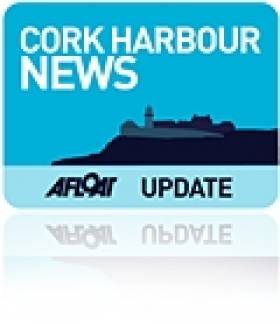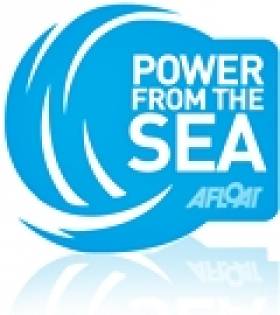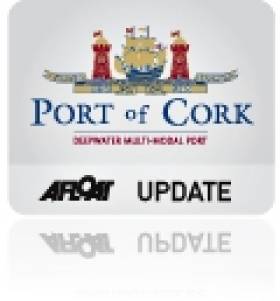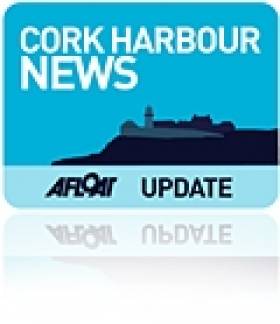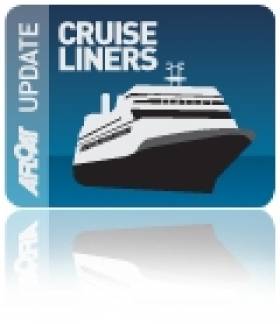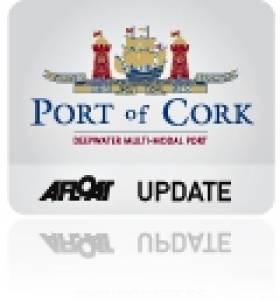Displaying items by tag: Ringaskiddy
EU Funding Endorses Port of Cork Ringaskiddy Development
#portofcork – The Port of Cork has secured EU funding from the Connecting Europe Facility (CEF) – Transport sector. As a Trans-European Transport Network (TEN-T) project, over €12.3 million was allocated for the Port's Ringaskiddy Redevelopment Project, further endorsing the Port of Cork as a vital link in the European transport network.
The Ringaskiddy Redevelopment Project, which will ultimately amount to an investment of around €100 million, will form an extension to the existing facilities that the Port currently operates in Ringaskiddy.
Speaking about the funding investment secured from the EU, Mr Denis Healy, Manager Engineering Services, Port of Cork said: "This funding will assist in ensuring the Port of Cork can meet future connectivity needs and will support the development of the wider regional and national economy which is of key importance to Cork."
He continued: "The funding will be invested in the first phase of the Ringaskiddy Port Redevelopment Project which was given the green light by An Bord Pleanala in May."
Launched in September 2014, the Connecting Europe Facility (CEF) call for proposals generated an unprecedented interest. The Commission received 700 applications totalling €36 billion of requested funding, three times more than the available envelope. This allowed the Commission to select the projects with the highest European added value, while guaranteeing a balanced distribution geographically and between the transport modes.
#ringsakiddy – The Port of Cork has welcomed the decision of An Bord Pleanála to grant planning permission for the Ringaskiddy Port Redevelopment project in the lower harbour. The development, which will ultimately amount to an investment of around €100 million, will form an extension to the existing facilities that the Port currently operates in Ringaskiddy.
Brendan Keating, Chief Executive of the Port of Cork said that while the decision and the conditions it entailed need to be considered in more detail, the Port is very pleased with the overall go-ahead from An Bord Pleanála. "Being able to accommodate larger vessels is of utmost importance if the Port of Cork is to remain competitive and continue to meet the needs of our customers and the economic developmental needs of the region. Today's decision will enable us to do this and in turn, future proof Cork as an international gateway for trade."
"We are conscious of the concerns raised by the residents of Cork harbour, particularly those raised at the oral hearing last September. We will be consulting further with residents and with all harbour users in relation to the development."
Securing future development potential for the Port of Cork, translates into significant economic benefits for Cork and the Munster region, as well as the national economy. 98% of goods imported or exported from Ireland are moved by ship, amounting to over €14 billion annually in Cork alone, highlighting the importance of ports to our economy.
This development is the first phase of the implementation of the Port of Cork's Strategic Development Plan Review (2010), the core principles of which were endorsed in the National Ports Policy, which highlighted Cork as a Tier 1 port of national significance.
Phase 1 of the Ringaskiddy Port Redevelopment project is expected to be operational in 2018. The overall project will facilitate, on a phased basis, the Port of Cork in transferring cargo handling activities from Tivoli and the City Quays in due course.
Marine Renewable Energy Sector Worth €9 Billion by 2030
#powerfromthesea – Ireland's marine renewable energy sector could ultimately be worth as much as €9 billion by 2030, and be supporting thousands of jobs on the island, according to Energy Minister Alex White. Speaking at the Marine Renewable Energy Ireland (MaREI) Industry Day, in Ringaskiddy, Co. Cork, Minister White also said his department's support for research and development in ocean renewables would increase by almost €17 million between 2013 and 2016, bringing it to over €26 million.
Minister White said Ireland had the potential to become the international focal point of the international marine renewable industry. He was in Ringaskiddy to perform the 'topping out' ceremony at the UCC Beaufort Building, which will be the hub of the Marine Renewable Energy Ireland (MaREI)from summer 2015. With up to 135 researchers, the Beaufort laboratory will house the world's largest group of marine renewable energy researchers.
Minister White said: "Ireland has a landmass of around 90,000 square kilometres. Our sea area is ten times that size, and it represents one of the best offshore renewable energy resources in the world. The development of Ireland's marine renewable energy sector will contribute to the generation of carbon-free renewable electricity. In the process, it will enhance the security of Ireland's energy supply, deliver green growth, and add to the 47,000 jobs already supported by Ireland's energy sector.
"Over time, the introduction of ocean energy into Ireland's renewables portfolio will result in an indigenous ocean sector with significant economic and employment benefits. You and your industry will be central to making these potential benefits a reality. Exchequer support for ocean research, development and demonstration has been increased. Between 2013 and 2016, €16.8 million was added to my Department's multi-annual ocean energy development budget, bringing the total cumulative funding to €26.3 million."
Minister White quoted the Sustainable Energy Authority of Ireland and Invest Northern Ireland, whose recently-published Economic Study for Ocean Energy Development in Ireland found that a fully-developed ocean energy sector could be worth as much as €9 billion, and be sustaining many thousands of jobs on this island, by 2030.
Minister Sean Sherlock in 2013, announced €19 million in SFI funding for MaREI, when he was Minister for Research and Innovation. This was matched by €10.5 million in industry funding.
Port of Cork Turnover Increases by Over 6% in 2013
#portofcork – 2013 proved a good year for the Port of Cork, who today reported an increase in traffic volumes from 9.05 million tonnes in 2012 to 9.12 million tonnes in 2013. Turnover amounted to €23.3 million in 2013, an increase of 6.59% and after deducting costs, the profit on ordinary activities before taxation amounted to €1.74 million, an increase of €0.371 million or 27%.
In 2013, the company maintained its commitment to capital investment by making additions to fixed assets of €5.89 million. This brings investment level by the company, since 1997, to €109 million.
The most notable investment in 2013 was the purchase of a new Liebherr LHM 550 crane for Ringaskiddy to support the increased imports of dry bulk cargos - cereals, animal feedstuffs, fertilisers - and to accommodate the Maersk Container transatlantic deep-sea direct service which commenced in January 2012.
Commenting on the 2013 annual results for the Port of Cork, Chief Executive Brendan Keating said: 'I am pleased to announce our 2013 results today which have returned an increased performance on 2012. For the last couple of years, we have seen steady increases in our traffic volumes and annual performance, highlighting the slow but steady improvement in Ireland's economy.'
He continued: 'The Port of Cork Company and its Board of Directors in response to the needs of the economy and the consequential growth in business have lodged a planning application for port redevelopment at Ringaskiddy. Being able to offer improved port facilities to our customers, is key in the continued success and competitiveness of the region and our business.'
The Port of Cork, a tier 1 port of national significance is central to a brighter future for the Irish economy because of the value it brings in moving goods to market for both customers and businesses alike. Ireland requires reliable accessible ports to deliver prosperity in achieving this economic recovery in Ireland.
As one of the three EU Core Network Ports in the State, the Port of Cork was successful in securing EU TEN-T funding in 2013 to assist and support the statutory consent for the infrastructure development proposal planned for Ringaskiddy. On the 1st May 2014, the Port of Cork Company lodged a Planning Application for new Port Infrastructure in Ringaskiddy with An Bord Pleanala under the terms of the Strategic Infrastructure process.
In May 2013, the Bantry Bay Harbour Commissioners assets and trade transferred to the Port of Cork Company. Bantry Bay Port Company Limited was incorporated on the 19th December 2013 and is 100% owned by the Port of Cork Company. This Company was established to manage Bantry Bay Harbour with effect from 1st January 2014 and will in particular, complement the Port of Cork's existing operations.
A total of 62 cruise ships, carrying in excess of 122,500 passengers and crew to the Port of Cork arrived in 2013, making a very significant contribution to the economy of the region. The Port of Cork Company is committed to further development of the dedicated cruise facilities at the Cobh Cruise Terminal. Brittany Ferries continues to operate their weekly successful service between Cork and Roscoff.
Cork Harbour Planning Application Lodged for Ringaskiddy Port Development by Port of Cork
#portofcork – The Port of Cork Company has lodged a planning application with An Bord Pleanála for the Ringaskiddy Port Redevelopment project in the lower harbour. The application is being made under the Planning and Development (Strategic Infrastructure) Act.
The planning application to An Bord Pleanála includes the following redevelopments under which will form an extension to the existing facilities which currently operate at Ringaskiddy.
The Ringaskiddy Port Redevelopment project consists of four key areas:
Ringaskiddy East (Container Berths and Multi-purpose Berth (CB/ (MPB))
• A new 314m Container Berth 1/ Multipurpose Berth that will be capable of accommodating vessels carrying a range of different cargoes including containers, freight and general cargoes;
• An additional 200m Container Berth 2
• Surfacing of existing port lands to provide operational areas;
• Dredging of the seabed (at new berths) to a level of -13.0 m Chart Datum (CD);
• Demolition of existing link-span
• Installation of link-span comprising a floating pontoon and access bridge;
• Installation of container handling cranes and terminal transport equipment;
• Maintenance building, administrative buildings and entrance kiosks; and
• Ancillary car parking, lighting and fencing.
Ringaskiddy West (Deep-water Berth Extension)
• A new 182m extension to the existing Deep-water Berth (DWB) which will comprise a filled quay structure extending no further seaward than the edge of the existing DWB;
• Dredging works (within Ringaskiddy basin) to varying levels to facilitate navigational access to the new facilities; and
• Lighting.
Road Improvements
• Improvements to the external road entrance into the Ringaskiddy Deep-water Terminal and to Ringaskiddy West;
• Improvements to the internal link road between Ringaskiddy East and Ringaskiddy West;
• Road improvement works within the existing harbour lands at Ringaskiddy East;
• Improvements to internal road network at Ringaskiddy East to facilitate future access to the N28; and
• Lighting and fencing.
Paddy's Point Amenity Area
• Construction of a new public pier, slipway and boarding platform;
• New planting and landscaping to provide public amenity area;
• Boat storage, lighting and fencing.
These plans are the first phase of the implementation of the Port of Cork's Strategic Development Plan Review (2010), the core principles of which were endorsed in the National Ports Policy, which highlighted Cork as a Tier 1 port of national significance. This Policy also identified the continued commercial development of the Port of Cork Company as a key strategic objective.
Over the last twelve months, the Port of Cork has carried out a number public open days and public consultation, to both inform and listen to the stakeholders around the harbour. Where possible, the comments from residents and communities within the harbour were considered and some amendments were made to the proposed plans presented at the time.
Speaking about the planning application, Brendan Keating, Chief Executive, Port of Cork said: "We have had constructive pre-application engagement with An Bord Pleanala to date and we are pleased to be lodging our planning application for Ringaskiddy Port Redevelopment today. Our needs as a port of national significance have not changed and as a Tier 1 port, the Port of Cork must be able to meet the needs of the region and those of our customers."
He continued: "Being able to accommodate larger vessels is of utmost importance if the Port of Cork is to remain competitive and future proof Cork as an international gateway for trade."
The key drivers of the rationale and need for the proposed Ringaskiddy Port Developments include the existing physical constraints in handling larger vessels and the changing nature of port activities, including the trend towards port-centred logistics. Addressing these needs would allow the Port of Cork to meet and secure its future development potential, and this would translate into significant quantified economic benefits for Cork and the surrounding region, as well as the national economy
The Port of Cork is a key link to the economic success of Ireland, in particular the entire Munster region. 98% of goods imported or exported from Ireland are moved by ship, highlighting the importance of ports to our economy.
The application documents including the Environmental Impact Statement and Natura Impact Statement may be inspected free of charge or purchased on payment of a specified fee (which shall not exceed the reasonable cost of making such copy) during public opening hours for a period of seven weeks commencing on 8th May 2014 at the following locations:
• The Offices of An Bord Pleanála, 64 Marlborough Street, Dublin 1;
• The Offices of Cork County Council, County Hall, Cork;
The application documents may also be viewed on the following website: http://www.ringaskiddyportredevelopment.ie from Friday 2nd May 2014.
A further public copy will be available for viewing only, during public opening hours, at The Foyer of National Maritime College of Ireland, Ringaskiddy, Co. Cork, from Tuesday 6th May 2014.
Waste Firm Drops Court Challenge Over Cork Harbour Incinerator
#CORK HARBOUR NEWS - A waste management firm has dropped its High Court challenge against the refusal of planning permission for an incinerator in Cork Harbour, the Irish Examiner reports.
Indaver last night pulled out of its legal challenge just days before a full judicial review of An Bord Pleanála's decision on the €140 million project in Ringaskiddy was set to begin.
However, a harbour residents group opposed to the incinerator proposals have given the "shock" move a cautious welcome.
Chase urged Indaver to "finally walk away" from the project as it has emerged the company is in pre-applications talks with An Bord Pleanála under its 'strategic infrastructure' process.
The Irish Examiner has more on the story HERE.
Navy Look to the Skies with Fuel-Saving Kite
#NAVAL SERVICE-The Naval Service are considering wind-power in an effort to reduce soaring fuel costs using "kite sails", reports the Examiner.
Commodore Mark Mellett confirmed the navy was collaborating with Irish Maritime and Energy Resource Cluster (IMERC), UCC, and CIT to develop "kite sails" which would be used to save fuel when a ship was carrying out surveillance.
"The kites would be used to reduce our energy bills, as we use 40% of the fuel allocated to the Defence Forces," said the commodore. "They could provide us with a speed of up to eight knots, which is as fast as a normal trawler."
The sails will have an added hi-tech edge (fitted with sensors to enhance the ships' radar capacity) which the service hopes to sell to other navies around the world. To read more about this story click HERE
Cork Cruise Caller Line-Up for 2012
#CRUISE LINERS – The Port of Cork is to welcome 60 cruise vessels this season, an increase on 2011 levels when 53 calls were made, bringing over 100,000 passengers and crew to the region, writes Jehan Ashmore.
According to UK Consultants GP Wild, the average in-transit spend per passenger, while visiting an Irish port is between €73- €100 which provides a significant contribution towards the local tourism economy.
Last year Cork won 1st place for 'Best Destination Experience (Organised)' in the world and 2nd place for 'Best Port Welcome' in the Dream World Cruise Destinations Awards.
Fred Olsen Cruise Lines Balmoral is the first caller for 2012 when she is to dock at Cobh in April. Larger cruise ships to visit during the season include Celebrity Eclipse, Emerald Princess, Independence of the Seas, Costa Deliziosa and Caribbean Princess.
In addition Cunard Line's Queen Elizabeth is to return to Cobh in August. Her inaugural Irish visit was in September last year, when the 90,000 tonnes vessel called firstly to Dublin followed by Cobh, to read more click HERE.
For a list of the cruise schedule, click HERE, noting several calls are to Ringaskiddy and North Custom House Quay in Cork City.
Port of Cork to Submit New Container Terminal Plans
#PORT & SHIPPING NEWS - The Port of Cork is scaling down its plans for a new container terminal in Ringaskiddy, according to the Irish Examiner.
The new plan is "significantly scaled back" from the €220 million containter terminal proposal for Oysterbank, which was rejected at appeals stage two years ago.
Port officials hope to submit the new application under the Strategic Infrastructure Act, which means the decision will be made by An Bord Pleanála and not Cork County Council.
Officials are already in consultation with the planning board and interest groups around Cork Harbour to eliminate any issues before proceeding with the new scheme, which will be half the size of the previous plan and will involve less land reclamation.
Expected upgrades to the roads infrastructure in the area will also have an impact on the new proposals.
The €100 million plan would be constructed over four phases, to be fully operational by 2020.
The Irish Examiner has much more on the story HERE.
NMCI Open Day: Let’s Sea What You’re Made Of
The open day is primarily aimed at fourth-year transition and leaving certicifcate students. For further information, enquiries and bookings for groups contact NMCI Tel: (021) 497 0607 by email: [email protected] and also the website: www.nmci.ie


























